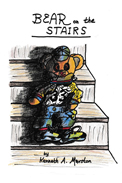
 |
Was most difficult and a real gut wrencher."
A neatly organized collection of short poetic works tells the story of one parent’s experience of loving, observing, and understanding his autistic son. Marston’s son, Neill, was plagued with several anomalies during and after his birth, and signs of autism soon emerged. At first, in line with the thinking at the time, medical specialists suggested institutionalization for the child, but his parents rejected that option.
From initially being nonverbal, Neill, who was obviously intelligent despite his Asperger’s symptoms, learned to communicate by using his teddy bear Mike as a go-between, almost like a ventriloquist. By offering structure and loving attention, Neill’s father, mother, and older sister gave Neill a safe, nurturing environment. And Mike the bear continued to play a role, becoming a symbol of Neill’s progress. Despite the bullying and teasing that unfortunately often disrupt the school and social environments of mentally handicapped children, “That cuddlesome bear gave Neill the courage to face trials. / He made excellent progress by leaps, bounds and miles.” With sensitive oversight, the boy learned to behave in school, use a computer quite competently, perform while playing the guitar, rollerblade, ski, play hockey, and ice skate. After high school, he began a serious study of graphic arts. Neill had a fulfilling and remarkable life but died tragically at age 23.
Marston’s poetic creations recount the memories—poignant, humorous, significant, and emotive—surrounding the challenge of helping Neill to mature in an enjoyable, appropriate way. Neill and his father hiked, played football, and once lay outside and looked at the stars together. The author’s rhymes are often made for entertaining effect while also giving personal glimpses into the general bafflement that a parent may encounter in raising an autistic child. One example was when, at an early age, Neill pulled out his upper eyelashes: “Once he talked, I asked him why. ‘Because they stinged!’ was his reply.”
Other recollections are arrayed in poetic format minus rhyme, serving as mini-essays on the notable happenings that characterized Neill’s upbringing. Particularly affecting are Marston’s memories of Neill’s funeral, at which Mike was placed in a chair in front of the podium. More than four hundred people attended the service, giving credence to his father’s assertion that Neill was a truly great person, despite or because of his handicaps. Having experienced grief over a long period of time, Marston explores that phenomenon at some depth, listing its many stages—numbness, rage, loneliness and pain—that can eventually be subsumed in acceptance and fond memories.
The good times and the crucially upsetting ones, along with the sorrow of loss, are revealed in appropriate proportions through the author’s chosen format. Thus the amusing incidents have their place along with the distressing times, with neither predominating. It is a well-considered strategy, with small, colorful, cartoon illustrations accompanying each segment of text. Marston asserts that people labeled “mentally dysfunctional” are “truly normal,” and, like Neill, need a vigilant, caring family and cooperative support systems to help them function to the fullest extent of their capabilities. Undoubtedly, parents of such children seeking guidance and encouragement, as well as professionals working with autistic and other differently developing children, will take inspiration from Marston’s vivid memories and gentle advice.
RECOMMENDED by the US Review